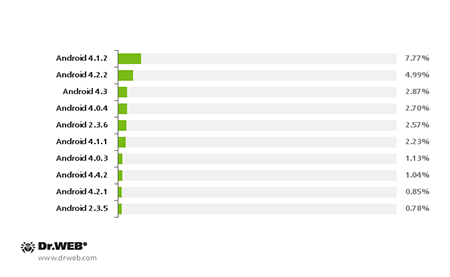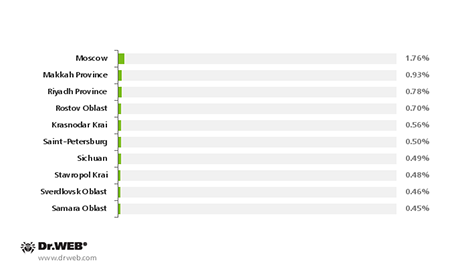Mobile threats in April 2014
Hot news | Threats to mobile devices | All the news | Virus alerts
May 5, 2014
Overall, from April 1-29, 815,293 incidents detected by Dr.Web for Android were registered by the company’s virus analysts. As before, the anti-virus most frequently identified applications containing advertisement modules that generated a profit for the developers of the respective applications. These modules include Adware.Airpush, Adware.Revmob, and Adware.Leadbolt. The SMS bot Android.SmsBot.65.origin turned out to be the most common malware in April—it was detected on 262,267 Android-powered devices. And, having infected 138,407 smart phones and tablets, the SMS Trojans Android.SmsSend.1088.origin and Android.SmsSend.458 are in second place in these rather unusual rankings. The top ten malicious programs discovered by Dr.Web for Android in April are listed in the table below:
| № | Threat name | % |
|---|---|---|
| 1 | Android.SmsBot.65.origin | 3,07 |
| 2 | Android.SmsSend.1088.origin, Android.SmsSend.458 | 2,03 |
| 3 | Android.SmsSend.315.origin | 1,95 |
| 4 | Android.SmsBot.60.origin | 1,74 |
| 5 | Android.Backdoor.69.origin | 1,73 |
| 6 | Android.SmsSend.466.origin | 1,37 |
| 7 | Android.Spy.83.origin | 1,36 |
| 8 | Android.SmsSend.859.origin | 1,25 |
| 9 | Android.SmsBot.55.origin | 1,16 |
| 10 | Android.SmsSend.685.origin | 0,93 |
The greatest number of threats—263,806—were identified by the anti-virus on April 23, and the minimum—193,987—was observed on April 21, 2014.
When a threat was detected, 47% of users chose to immediately uninstall the malware, while 38.6% removed the apk file from the device’s memory before installation if a malicious or undesirable component was detected in the file.
Most infected mobile devices were running Android 4.1.2. Android 4.2.2 and 4.3 rank second and third, respectively. Summary statistics regarding the versions of Android used on infected devices are shown in the following diagram:
Versions of Android installed on devices on which infection was discovered (April 2014)
According to statistics collected with the help of Dr.Web Anti-virus for Android, Moscow proved to be the most severely compromised region in April (1.76 %); Saudi Arabia’s Mecca (0.93%) and Riyadh (0.78 %) ranked second and third. Overall statistics on the territorial distribution of infections are shown in the following diagram:
The Geographical distribution of infections by Trojans for Android (April 2014) 
Doctor Web will continue to closely monitor the spread of threats to Android and promptly inform users about new malware.
Learn more with Dr.Web
Virus statistics Virus descriptions Virus monthly reviews Laboratory-live